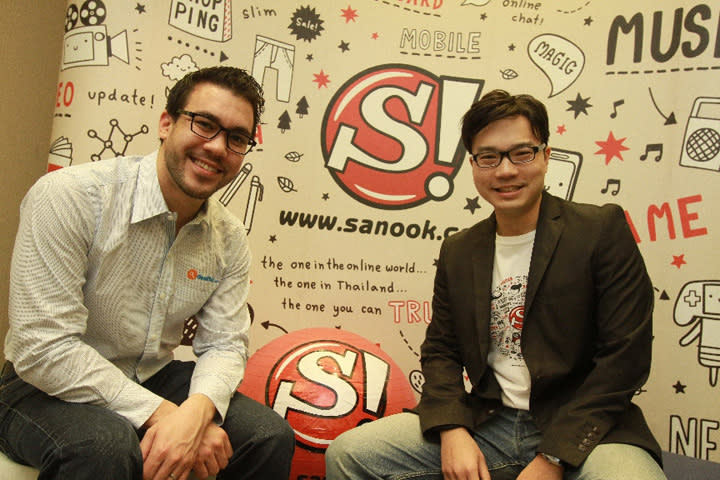The Future of Sanook: Thailand's Largest Web Portal

You may not have heard of Sanook, but by internet standards, the company is a grizzled veteran in Thailand, founded by Poramate Minsiri way back in 1998. Over the years it has expanded to offer a number of services and products, including e-commerce, games, news content, advertising, and mobile applications. Today, it is the largest web portal in Thailand.
The company’s e-commerce arm includes Dealfish, a C2C e-commerce marketplace and Sabuy, and B2B2C e-commerce site. This division is led by managing director Tiwa York. The internet portal section and other divisions like mobile, games, and advertising are led by Krittee Manoleehagul, the managing director at Sanook Online Limited.
Part-owned by Tencent and MIH
Sanook started as a Thai-based web directory in 1998 under parent company MWEB. After just a year, MWEB was acquired by MIH Group (under Nasper) (1).
In 1999, the Thai company rebranded fully to Sanook and placed every entity under the single domain of Sanook.com. Back in the 90s, there wasn’t any Thai language portal, and portal sites were really the big thing in the internet business. It took off, and in August 2010, Tencent bought 49.92 percent of Sanook.com. At that time, Sanook.com had about 13 million monthly unique visitors generating 400 million pageviews a month.
Sanook, Mobile, and WeChat
Today Sanook.com boasts a whopping 18.5 million monthly unique visitors generating over 500 million pageviews each month. It has its own editorial team but also syndicates content via other web sources as well.
Krittee says that the top three priorities of his department are WeChat, Sanook.com, and mobile. He estimated that there are about 10 to 15 million smartphone users, about 20 percent of the Thai market, and that number will continue to grow over time. Moving with the mobile trend in Thailand, he says that some of the most popular content on the Sanook portal (like horoscopes, news, and restaurant reviews) are now available on app stores. Krittee adds:
Tiwa and I started looking at certain verticals and said, “Look, this has potential let’s pull it out.” […] Like restaurant reviews, eventually who knows, we might be able to develop it into a business where users can book in advance through the application. [It’s more than just] reviews, you can do more than that.

Tiwa York (Left) and Krittee Manoleehagul (right) Working with WeChat
The Thai internet giant also runs the mobile messaging app WeChat in Thailand as Sanook is partly owned by Tencent, one of the largest internet companies in China.

For Sanook, working with brands is one of the key strategies they believe can add value for Thai users. Krittee cities Thai beverage giant Chang as an example, the brand that provides utility convenience to its users through WeChat. Users can order deliveries from Chang (E.g. Water refills), a classic case of online-to-offline engagement through mobile.
From a business point of view, Sanook does not only provide online engagement through WeChat for brands. It provides more of a holistic online marketing platform by offering advertising media on its portal. It also helps manage the brand’s Facebook page through Sanook-owned ad agency, Top Space.
We just started this (WeChat engagement) at the end of last year. I don’t think the brands [in Thailand] really understand this whole concept yet. And that’s what we’re trying to do. We see ourselves as marketing consultants […] making them think about the customer lifecycle and how to reach their customers across every touch point.
Krittee said that the number of WeChat users in Thailand “is in the millions” but declined to give an exact figure.
Games are also another one of Sanook’s key verticals. Right now Sanook does Flash and social games but Krittee doesn’t believe that it’s the future. Mobile games will be its focus. Sanook licenses game content and localizes it for the Thai market. WeChat, as faithful readers know, is working on a mobile gaming platform but Sanook’s games won’t be on the platform right away. Krittee is careful not to be overly reliant on WeChat and doesn’t want to start plugging too many things into WeChat just yet.
E-commerce: Sabuy and Dealfish
Sabuy and Dealfish are the two key e-commerce divisions under Sanook. Dealfish, Sanook’s C2C marketplace, was established as a standalone website in September 2011. According to local web analytics site Truehits, Dealfish attracts more than 250,000 unique visitors each day and has an average of 240,000 listings (with a 45 days auto-expiry) generated by 213,000 sellers.
Dealfish works more like a Craigslist rather than something like Taobao — meaning it does not facilitate transactions between users. Embracing social, Dealfish allows cross posting from Facebook to its marketplace listings. The service also has city/region-level listings. For example, chiangmai.dealfish.co.th allows users to view all the listings from Chiang Mai only.
The site is currently free to use, although Tiwa does have plans to implement a freemium model for more serious sellers on Dealfish. But monetization is not yet on his list of priorities. He tells me:
The whole role of business (for Dealfish) is to connect and activate local commerce. Our vision of the business is just that. That’s why we are not in the hurry to monetize. We want to actively provide a great service where people can trade.
Tiwa also revealed that Dealfish will soon roll out its mobile application which inevitably seems to be a direct competition with Shopspot.
In addition to Dealfish, Sanook also has its B2B2C e-commerce property called Sabuy, which is home to more than 1,400 merchants with 210,000 products listed. Sabuy was first launched in November 2007 in a partnership with eBay. After the partnership expired at the end of 2011, Tiwa and his team rebranded it to Sabuy and ran the e-commerce site under the Sanook brand.
We wanted to take the Sabuy business in a certain direction, and we have a vision for being a brightly lit mall model that is safe for all buyers.
The rebranding of Sabuy in late 2011 was also coupled with the Sabuy Guarantee, which promises no defects or late deliveries. Sabuy is also strict when selecting retailers to work with, making sure they are able to meet with Sabuy’s standards of service. In Thailand, Sabuy’s closest competitor is Rakuten’s Tarad.com.
According to Sabuy’s own figures, 35 percent of its customers use ATM and internet bank transfer, and 35 percent pay through counters or at 7-Eleven. The remaining 30 percent pay using credit cards. Two-thirds of all Sabuy’s orders are from outside of Bangkok.

“Our job is to take Sanook to the next level,” said Krittee.
As my interview with Tiwa and Krittee ended, I heard some Sanook staffers singing a birthday song for one of their team members. Tiwa and Krittee walked out of the meeting room to pass on their birthday wishes, mixing naturally with the rest of the staffers. The party went on as I headed off.
Sanook’s culture feels right for an internet company. And its future looks solid under the leadership of Tiwa and Krittee.
(1) MIH Group invests in promising companies in emerging markets. In Asia alone, it owns part of Tencent (China), Ibibo (India), Tokobagus (Indonesia), Mulitply (Indonesia), and many more.
The post The Future of Sanook: Thailand's Largest Web Portal appeared first on Tech in Asia.



